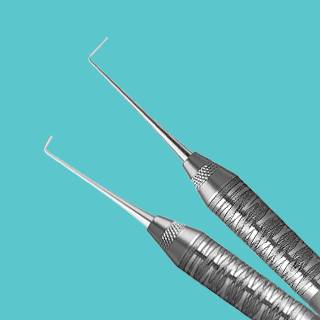Blog
Why All The Root Canal Hate?

Saving Smiles with Modern Endodontics
 Contemplating Root Canal Awareness Week got me thinking about the profound strides the field of endodontics has taken over recent decades, juxtaposed with the considerable distance it still must traverse—particularly in reshaping its perception among both patients and dental professionals.
Contemplating Root Canal Awareness Week got me thinking about the profound strides the field of endodontics has taken over recent decades, juxtaposed with the considerable distance it still must traverse—particularly in reshaping its perception among both patients and dental professionals.
According to the American Association of Endodontists, we're hailed as "THE SUPERHEROES OF SAVING TEETH." And I find that assertion to be undeniably true.
Each year, Root Canal Treatments rescue over 15 million smiles in the USA alone! Yet, it's disheartening to encounter patients and, regrettably, some peers within the dental community dismissing teeth necessitating root canal intervention as unworthy of salvage. Instead, they advocate for dental implants as a superior alternative. However, emerging research is illuminating the long-term complications associated with dental implants. Hence, it's prudent to prioritize preserving the natural tooth whenever feasible, before resorting to implantation.
The annual commemoration of Root Canal Awareness Week by the AAE is not only apt but imperative. It serves as a vital platform for honoring the invaluable contributions of endodontists and dispelling misconceptions surrounding the enduring efficacy of root canal procedures. Unfounded fears and misbeliefs are unduly curtailing patients' prospects of enjoying sustained dental health and functionality.
Today, our array of endodontic procedures aims not only to alleviate pain but also to prevent further infection of the jawbone while preserving the functionality of teeth. However, to achieve these goals effectively, a few key elements are imperative:
- Expert Operators: Skilled, well-trained professionals are indispensable for precise diagnosis and treatment.
- Cutting-Edge technology: The most advanced instruments and equipment are essential for optimal outcomes.
Over the past two decades, the landscape of endodontics has undergone a remarkable transformation akin to a whirlwind. This journey commenced with the adoption of rotary instruments and apex locators, evolving further with the widespread integration of dental operating microscopes and Cone Beam Computed Technology (CBCT). Most recently, the introduction of enhanced disinfection devices that can further assist clinicians on their mission to save teeth.
With this groundbreaking technology, practitioners like me can meticulously evaluate root canal anatomy, associated structures in three dimensions, operate under a high level of precision, and determine the optimal treatment strategies for each patients. Such technology is no longer limited to hand-full of clinicians, but pretty much in every endodontic office.
Root canal treatment hurts…right?

Dispelling the persistent myth surrounding root canal procedures, it's essential to underscore that contemporary practices render root canal treatments virtually pain-free. Thanks to modern instrumentation and the adept administration of anesthesia, patients can anticipate minimal to no discomfort during procedures. Any post-procedural discomfort, akin to that experienced with any surgical intervention, can be effectively managed with pain medication, and typically subsides within a week or less.
A prevailing misconception suggests that endodontically treated teeth may swiftly lose their functionality—a fallacy often rooted in inadequate post-treatment restoration. Research indicates that a staggering 97 percent of teeth undergoing root canal treatment remain functional for at least eight years. However, among extracted teeth, 85 percent lack permanent restoration.
Patients must grasp the importance of promptly restoring teeth post-root canal treatment, typically with a crown to fortify them against further damage. Failure to restore teeth predisposes them to fracture and premature loss—a risk underscored by recent findings indicating a significant impact on tooth survivability when crowning is delayed beyond two months post-treatment.
Ultimately, prevention reigns supreme in the realm of endodontic care. Early screenings facilitate the preservation of tooth vitality, potentially obviating the need for root canal intervention altogether. Regular follow-ups post-treatment are paramount, ensuring the continued health, disease-free status, and functionality of treated teeth. These brief, complimentary appointments serve as invaluable checkpoints in maintaining optimal oral health.
As Root Canal Awareness Week annually reminds us, endodontics stands as a pivotal dental specialty, a bastion against suffering, and a beacon for tooth preservation. The synergy of modern technology and dedicated professionals wielding precision instruments heralds a future where healthy, functional smiles endure.
Azim Bio

Dr. Azim is an Associate Professor, Chair of the Endodontic Department, and the Director of the Post-Graduate Program at University of the Pacific, Arthur A. Dugoni School of Dentistry. He maintains a private practice limited to Endodontics and he is also the Founder and CEO of Endolit.
Dr. Azim earned his BDS from Cairo University, where he also did his Endodontic training. He later completed his Endodontic certificate at Columbia University, and since then, he has been a full-time Educator and a Part-Time Private Practitioner. Before Joining the University of the Pacific, he Served as the Division Head and the Director of the Endodontic Post-Graduate Program at University at Buffalo.
Dr. Azim is the recipient of the 2023 AAE Edward M. Osetek Award for outstanding educators. He is Diplomate of the American Board of Endodontics and has lectured all over the world. He has over 40 publications in peer-reviewed journals and several text-book chapters contributions. He is a member of the Scientific Advisory Board of the Journal of Endodontics, and a reviewer for multiple other Endodontic Journals.

